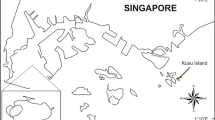Abstract
Anthropogenic climate change is the biggest threat to coral reefs, but reef restoration efforts are buying time for these ecosystems. Lesion recovery, which can be a determinant of colony survival, is particularly important for restored species. Here, we evaluate lesion recovery of 18 genets of Acropora cervicornis from Florida reefs with different thermal regimes in a temperature challenge experiment. Genets demonstrated significant variability in healing, which greatly slowed under heat stress. Only 35% of fragments healed at 31.5 °C compared to 99% at 28 °C. Donor reef thermal regime significantly influenced lesion recovery under heat stress with corals from warmer reefs demonstrating greater healing than corals from cooler reefs, but did not influence recovery under ambient conditions. These findings should encourage practitioners to utilize rapidly healing genets, avoid fragmentation in high temperatures, and incorporate assisted relocation by moving corals from warmer to cooler reefs, where they might succeed under future climate conditions.



Similar content being viewed by others
References
Aronson RB, Precht WF (2001) The ecology and etiology of newly emerging marine diseases. Hydrobiologia 460:25–38
Bak RPM (1983) Neoplasia, regeneration and growth in the reef-building coral Acropora palmata. Mar Biol 77:221–227
Baums IB, Baker AC, Davies SW, Grottoli AG, Kenkel CD, Kitchen SA, Kuffner IB, LaJeunesse TC, Matz MV, Miller MW, Parkinson JE, Shantz AA (2019) Considerations for maximizing the adaptive potential of restored coral populations in the western Atlantic. Ecol Appl 29. https://doi.org/10.1002/eap.1978
Bonesso JL, Leggat W, Ainsworth TD (2017) Exposure to elevated sea-surface temperatures below the bleaching threshold impairs coral recovery and regeneration following injury. PeerJ 5:e3719. https://doi.org/10.7717/peerj.3719
Casey KS, Brandon TB, Cornillon P, Evans R (2010) The past, present, and future of the AVHRR Pathfinder SST Program. Oceanography from space. Springer, Dodrecht, pp 273–287
Cramer KL, Jackson JBC, Donovan MK, Greenstein BJ, Korpanty CA, Cook GM, Pandolfi JM (2020) Widespread loss of Caribbean acroporid corals was underway before coral bleaching and disease outbreaks. Sci Adv 6:eaax9395. https://doi.org/10.1126/sciadv.aax9395
Drury C, Dale KE, Panlilio JM, Miller SV, Lirman D, Larson EA, Bartels E, Crawford DL, Oleksiak MF (2016) Genomic variation among populations of threatened coral: Acropora cervicornis. BMC Genom 17. https://doi.org/10.1186/s12864-016-2583-8
Eakin C, Sweatman H, Brainard R (2019) The 2014–2017 global-scale coral bleaching events: insights and impacts. Coral Reefs 38:539–545
Harborne AR, Rogers A, Bozec YM, Mumby PJ (2016) Multiple stressors and the functioning of coral reefs. Ann Rev Mar Sci 9:445–468
Highsmith RC (1982) Reproduction by fragmentation in corals. Mar Ecol Prog Ser 7:207–226
Kenkel CD, Goodbody-Gringley G, Caillaud D, Davies SW, Bartels E, Matz MV (2013) Evidence for a host role in thermotolerance divergence between populations of the mustard hill coral (Porites astreoides) from different reef environments. Mol Ecol 22:4335–4348
Kleinbaum DG, Klein M (2012) The stratified Cox procedure. Survival analysis. Springer-Verlag, New York, pp 173–210
Lirman D (2000) Lesion regeneration in the branching coral Acropora palmata: effects of colonization, colony size, lesion size, and lesion shape. Mar Ecol Prog Ser 197:209–215
Lirman D, Schopmeyer S (2016) Ecological solutions to reef degradation: optimizing coral reef restoration in the Caribbean and Western Atlantic. PeerJ 4:e2597. https://doi.org/10.7717/peerj.2597
Lirman D, Schopmeyer S, Galvan V, Drury C, Baker AC, Baums IB (2014) Growth dynamics of the threatened Caribbean staghorn coral Acropora cervicornis: influence of host genotype, symbiont identity, colony size, and environmental setting. PLoS ONE 9:e107253. https://doi.org/10.1371/journal.pone.0107253
Lohr KE, Patterson JT (2017) Intraspecific variation in phenotype among nursery-reared staghorn coral Acropora cervicornis (Lamarck, 1816). J Exp Mar Biol and Ecol 486:87–92
Meesters EH, Bak RPM (1993) Effects of coral bleaching on tissue regeneration potential and colony survival. Mar Ecol Prog Ser 96:189–198
Meesters EH, Bak RPM (1995) Age-related deterioration of a physiological function in the branching coral Acropora palmata. Mar Ecol Prog Ser 121:203–209
Miller MW, Colburn PJ, Pontes E, Williams DE, Bright AJ, Serrano XM, Peters EC (2019) Genotypic variation in disease susceptibility among cultured stocks of elkhorn and staghorn corals. PeerJ 7:e6751. https://doi.org/10.7717/peerj.6751
Morikawa MK, Palumbi SR (2019) Using naturally occurring climate resilient corals to construct bleaching-resistant nurseries. Proc Natl Acad Sci USA 116:10586–10591
National Academies of Sciences, Engineering, and Medicine (2018) A research review of interventions to increase the persistence and resilience of coral reefs. Washington DC: The National Academies Press. https://doi.org/10.17226/25279
Silverstein RN, Cunning R, Baker AC (2017) Tenacious D: symbiodinium in clade D remain in reef corals at both high and low temperature extremes despite impairment. J Exp Biol 220:1192–1196
Vargas-Angel B, Colley SB, Hoke SM, Thomas JD (2006) The reproductive seasonality and gametogenic cycle of Acropora cervicornis off Broward County, Florida, USA. Coral Reefs 25:110–122
Vollmer S, Palumbi SR (2007) Restricted gene flow in the Caribbean staghorn coral Acropora cervicornis: implications for the recovery of endangered reefs. J Hered 98:40–50
Young CN, Schopmeyer SA, Lirman D (2012) A review of reef restoration and Coral propagation using the threatened genus Acropora in the Caribbean and western Atlantic. Bull Mar Sci 88:1075–1098
Acknowledgements
We would like to thank D. Hesley, M. D’Alessandro, N. Rivas, J. Unsworth, and J. Carrick for their contributions to this project. This project was funded by NOAA’s Restoration Center (award OAA-NMFS-HCPO-2016-2004840). Corals were collected under Florida’s Fish and Wildlife Commission Permit SAL-19-1794-SCRP. MMM data were provided by GHRSST and the NOAA National Centers for Environmental Information.
Author information
Authors and Affiliations
Corresponding author
Ethics declarations
Conflict of interest
On behalf of all authors, the corresponding author states that there is no conflict of interest.
Additional information
Publisher's Note
Springer Nature remains neutral with regard to jurisdictional claims in published maps and institutional affiliations.
Topic Editor Steve Vollmer
Electronic supplementary material
Below is the link to the electronic supplementary material.
Rights and permissions
About this article
Cite this article
Kaufman, M.L., Watkins, E., van Hooidonk, R. et al. Thermal history influences lesion recovery of the threatened Caribbean staghorn coral Acropora cervicornis under heat stress. Coral Reefs 40, 289–293 (2021). https://doi.org/10.1007/s00338-020-02025-2
Received:
Accepted:
Published:
Issue Date:
DOI: https://doi.org/10.1007/s00338-020-02025-2




